COVID-19 trilemma tradeoffs: Public health, economic security and data privacy
The COVID-19 pandemic has been a shared experience. It has created unprecedented social challenges and presented a unique trilemma for consumers. People across the US are worried about their: (1) personal health and safety; (2) economic future and job security; and (3) individual privacy and liberty. And, based on an ongoing study by the IBM Institute for Business Value (IBV)—which has surveyed more than 54,000 respondents in the United States between April and July 2020—there doesn’t seem to be any relief in sight.
While society begins to adjust, two-thirds of individuals are concerned about a second wave of COVID-19 hitting later in 2020. And more than 60 percent expect to see more global pandemic events like COVID-19 in the months and years to come.
These concerns are exacerbated by a widespread lack of confidence in those who have the most control over our shared futures. Less than half of respondents say the actions taken by government leaders and employers in response to the COVID-19 pandemic were reasonable and appropriate. And when it comes to making ethical decisions about reopening, most lack trust in their employers, elected leaders, and public health officials at all levels.
Consumers in the US weigh a trilemma of concerns
To gain deeper insight into consumer tradeoffs—preventing sickness, growing the economy, and protecting privacy—we asked respondents to indicate which of the factors was relatively more important for leaders to consider in dealing with public health events like the COVID-19 pandemic.
While most people prioritize human life and health, more than one in five say the economy and personal privacy and liberty are more important societal factors to consider when making decisions regarding the pandemic.
When asked to make a direct tradeoff about the relative importance between low infection and death rates and a strong economy in the near-term, more than 40 percent selected health, while more than 20 percent selected the economy.
This is not surprising given that, as a direct result of the COVID-19 crisis, 20 percent of Americans surveyed indicate they have either been temporarily furloughed or permanently laid off by their employer. Nearly 40 percent say the pandemic has made them worry about the security of their job.
In a head-to-head tradeoff between low infections and death rates and privacy and personal liberty, nearly half chose health, while more than 20 percent sided with privacy.
Interestingly, about a third of respondents struggled to make a choice about which factor was more important, and therefore prioritized all three equally.
Coronavirus concerns remain very real
While society reopens in fits and starts, most people are not optimistic about returning to any semblance of normalcy any time soon. More than 68 percent of individuals say they are more concerned than ever about the safety and health of their families, and one in ten people report that someone in their household has either tested positive or is showing symptoms of COVID-19. Nearly 40 percent are very or extremely worried that they or a family member may become infected and seriously ill as a result of this virus. Only 10 percent are not worried at all.
Nearly 60 percent of citizens are concerned that lifting stay-at-home restrictions will result in another outbreak of COVID-19 in the area where they live, and two-thirds are concerned about a second wave of the virus hitting their area later in 2020.
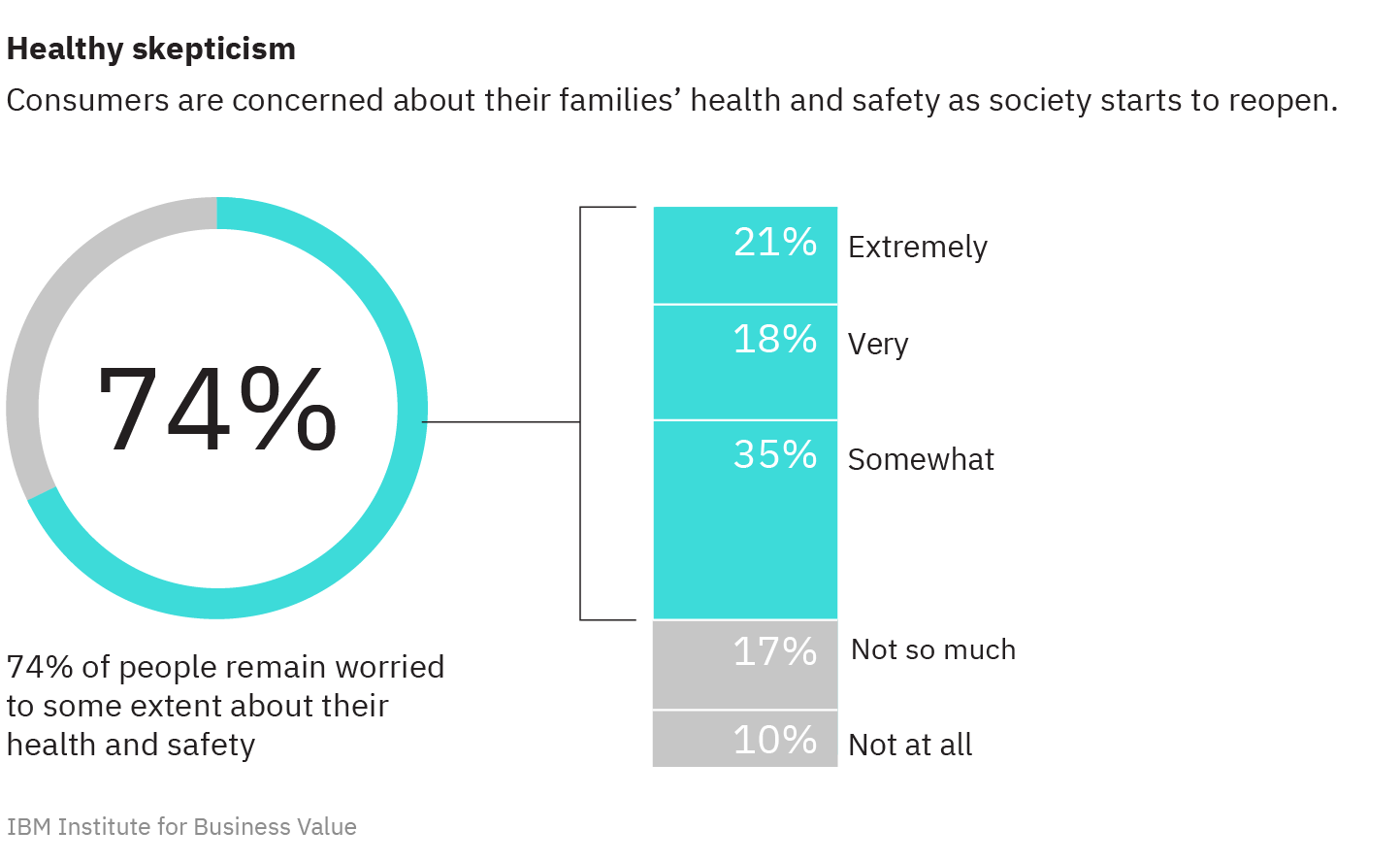
Consumers expect businesses to mitigate their risk of infection
Despite serious concerns about health and safety, large numbers of people are already going out and visiting businesses and public places. By the end of June 2020, 30 percent of people had already been to a doctor or dentist’s office, nearly a quarter had been to an outdoor park, and one in five had visited a restaurant or bar.
And a wider variety of venues may be on the table in the near future. More than half of respondents say they plan to visit a shopping mall, and significant numbers expect to visit a gym (45 percent), museum (43 percent), or live sporting event (40 percent) at some point this year.
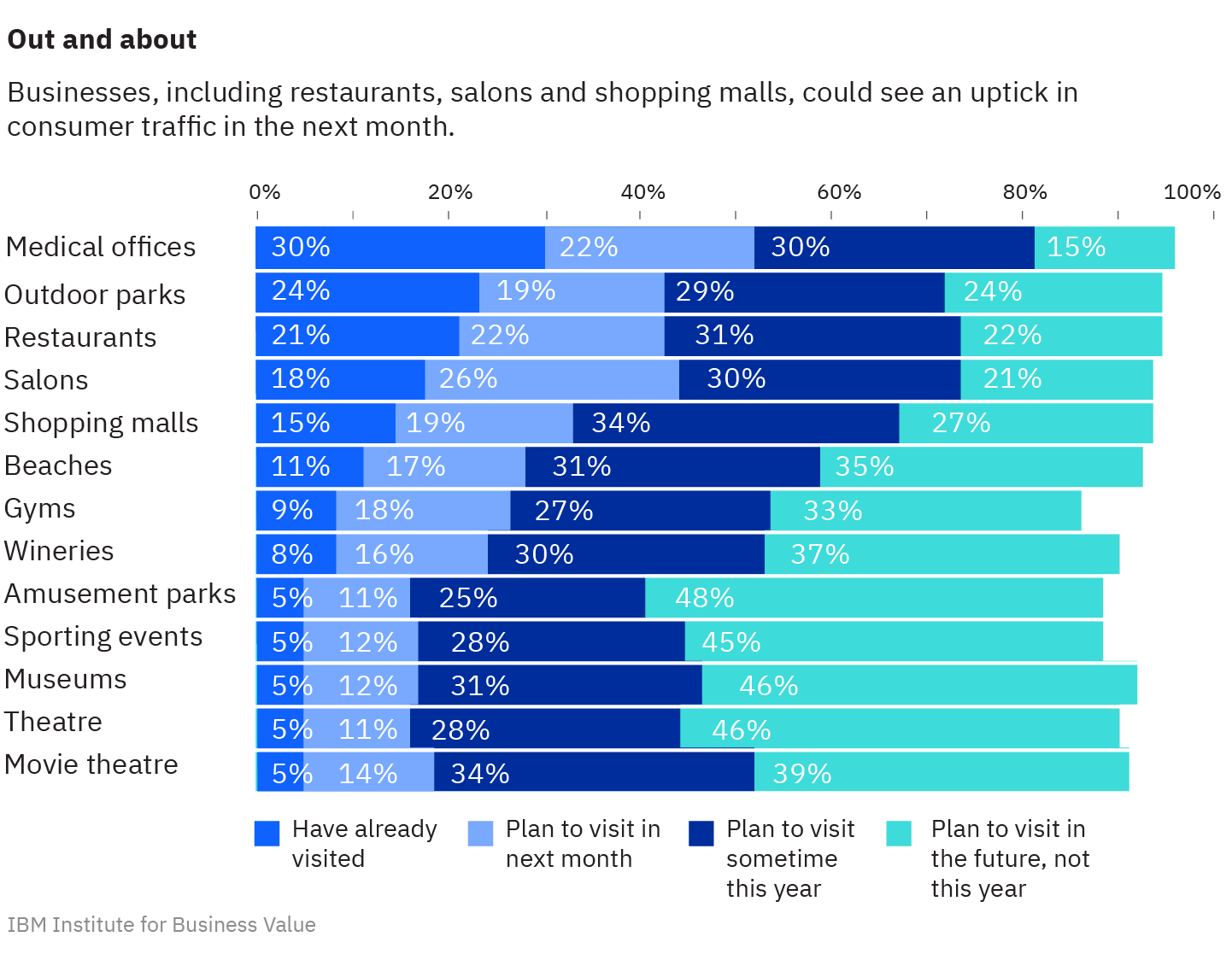
Travel plans fall victim to the lockdown
The pandemic has put a damper on summer vacation plans—and the long-term perspective of potential travelers is gloomy. Despite being under lockdown for months, one in four respondents indicate they still do not plan to travel for a long time. Nearly half (47 percent) of respondents appear eager to get out on the open road and take a journey by car. Meanwhile, only about one in five are interested in travelling by plane, and five percent or less have an interest in going on a journey by either train or cruise ship.
Many hotels and other lodging providers are not likely to see full houses again until 2021. Fewer than 40 percent of respondents indicate they are likely to go on an extended vacation which will require a stay in a hotel room, resort, or vacation rental home in the first six months after “safer at home” orders expire. About 1 in 4 expect to do so within the next year while more than a third have no plans to take an extended vacation.
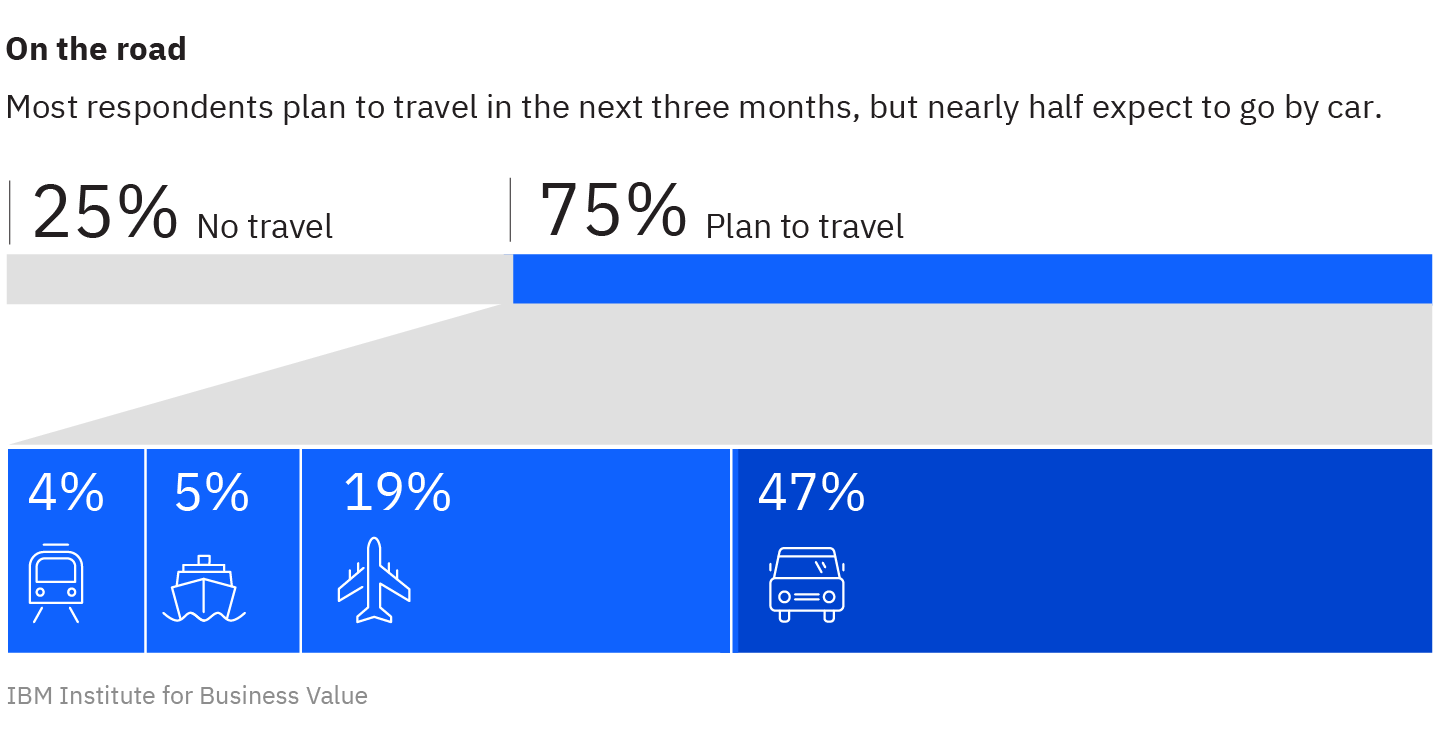
Protective measures expected
As they begin interacting, many people expect businesses and venues to take protective measures to help them feel safe and comfortable visiting in person. Two-thirds expect clearly communicated plans for, and the active promotion of, healthy hygiene and sanitation practices. Half say they expect social distancing for employees and patrons to be enforced, and 48 percent say they would feel comfortable if employees wore face coverings.
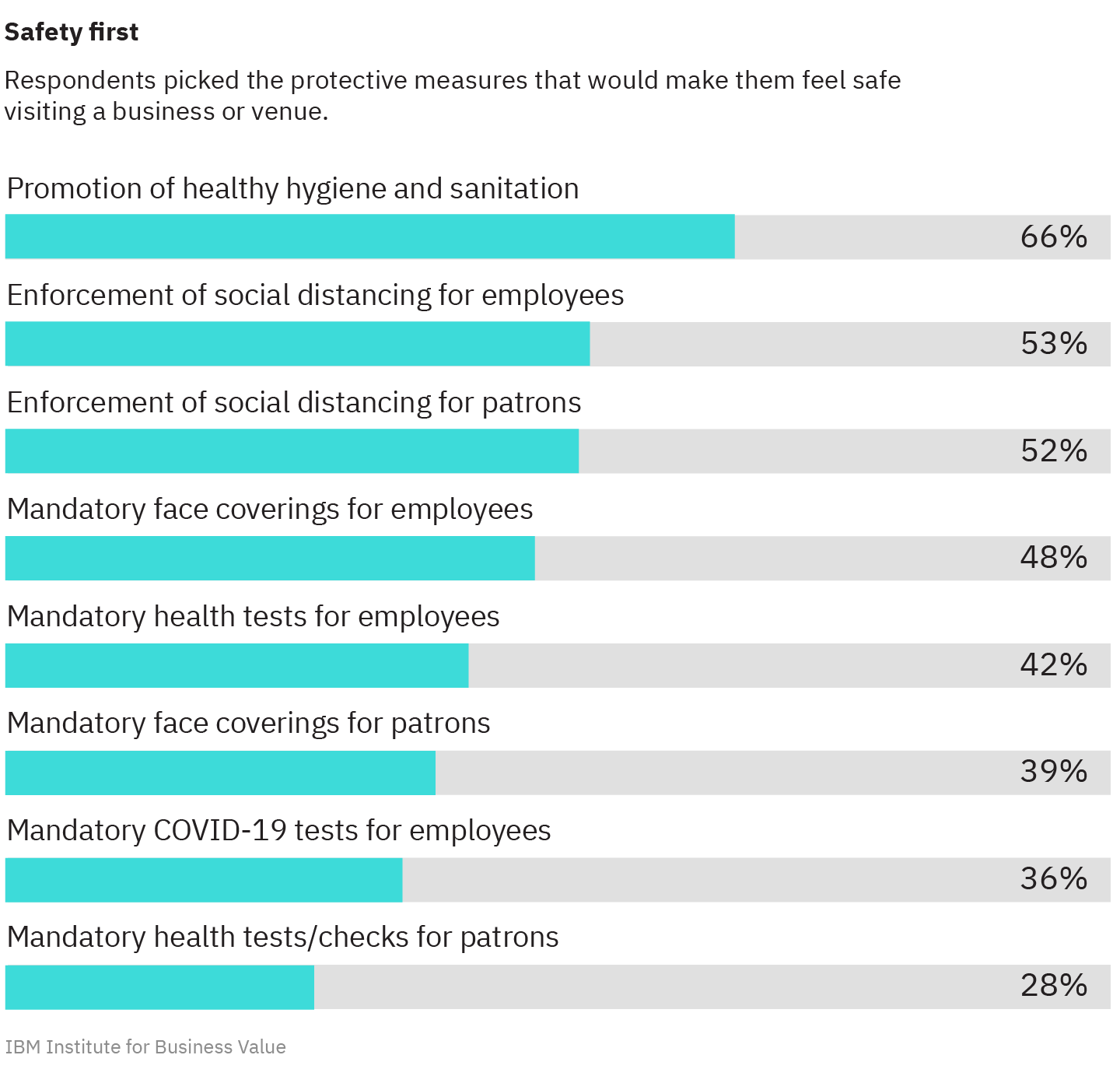
Returning to a workplace presents a unique opportunity and challenge
Employers get mixed reviews from employees as to their response to the COVID-19 crisis and how they’re taking care of their people. Fewer than one in four workers trust their employers to make informed and ethical decisions that consider both the economic implications and the health and well-being of individuals and communities when returning to the workplace.
Even so, about half of employees surveyed say that their employer is genuinely concerned about them, they’re receiving clear guidelines, and their employer is actively innovating to keep the business running.
However, most employees indicate their employers are not adequately meeting training needs, enabling remote work arrangements, or supporting their physical and emotional health.






Interestingly, while three-quarters of executives report they are successfully helping their employees learn the skills they need to operate in the new way, only a third of employees agree.
Similarly, 79 percent of employers say they are adequately supporting the physical and emotional health of the workforce, while only 44 percent of employees say the same.
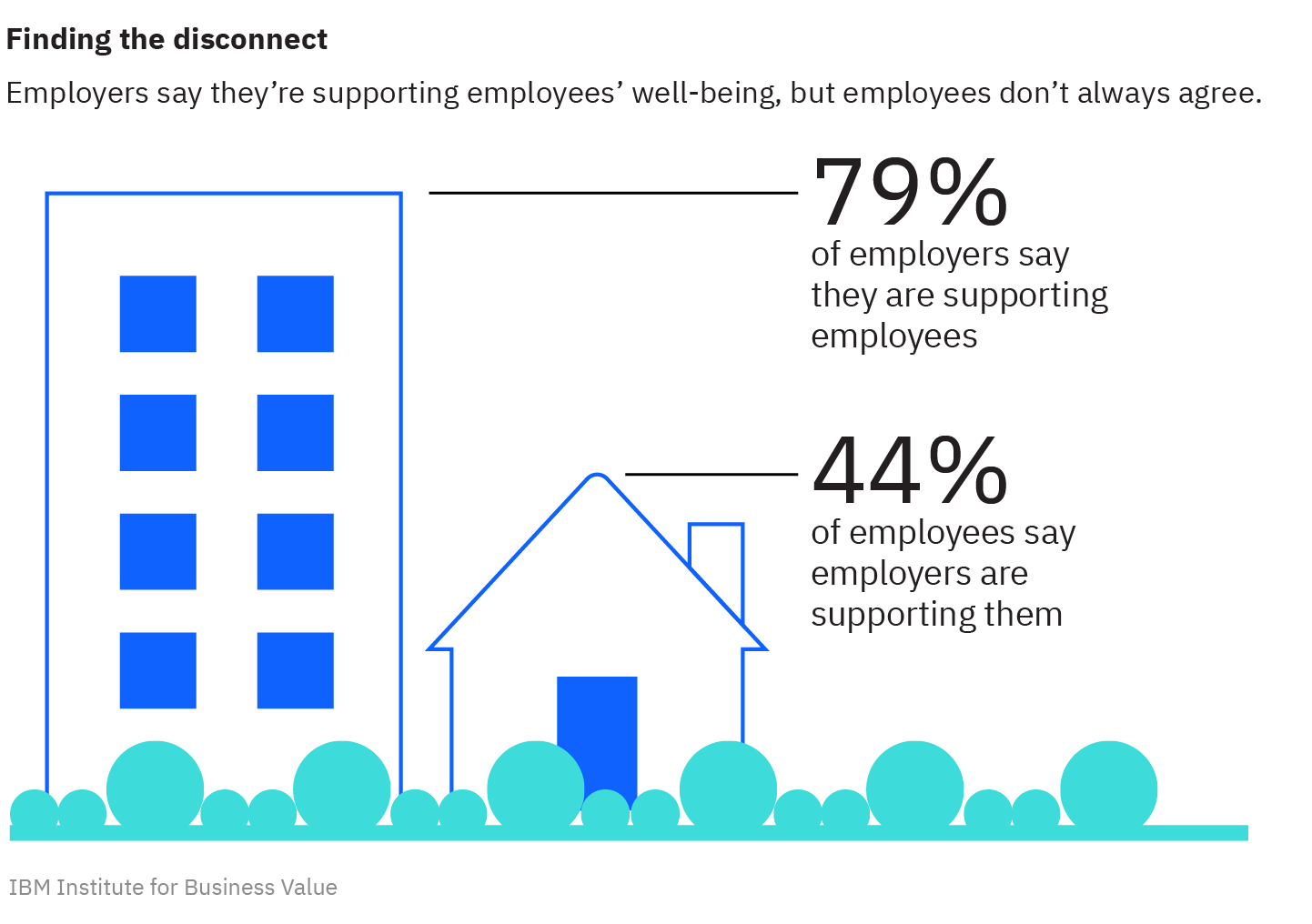
Employees have clear expectations around workplace safety
When asked what employers should have in place in order to return to normal work operations, many respondents strongly expect their employers to take a broad and active set of measures to protect them from exposure to the virus, and to provide them flexibility to protect their mental health and well-being.
More than half of respondents say there must be clear communication protocols in place to notify employees of what is being done to sanitize the workplace. And half also indicate that employers should clearly communicate plans for handling another outbreak—as well as provide paid leave for people who are sick or demonstrate symptoms of being sick.
Meanwhile, nearly half expect that employers should maintain social distancing in the workplace and nearly 1 in 3 strongly expect their employer to provide special accommodations for individuals to address childcare needs. Overall, respondents appear to be somewhat more demanding as more organizations return to the workplace. The numbers below reflect results from July 2020.
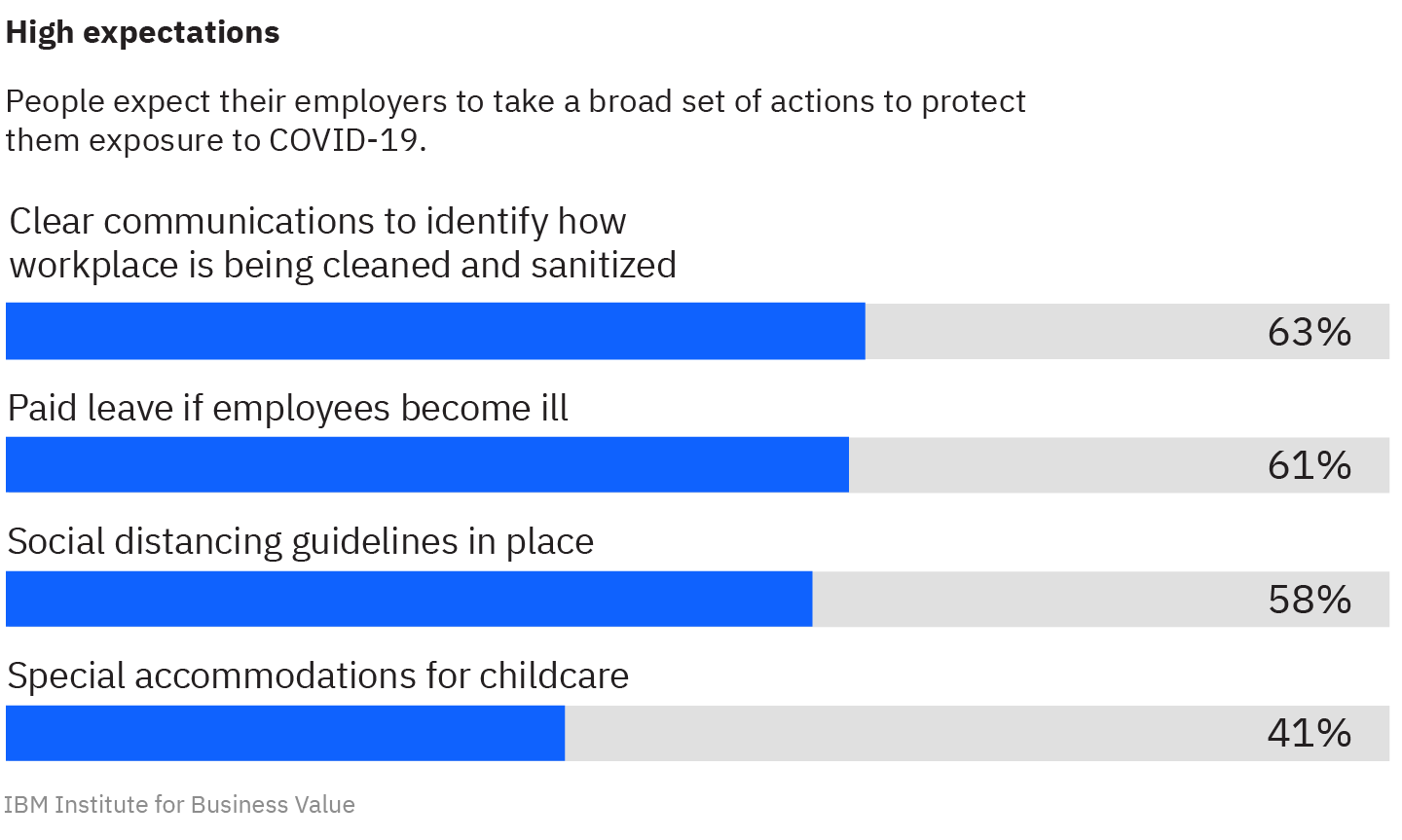
Interestingly, while three-quarters of executives report they are successfully helping their employees learn the skills they need to operate in the new way, only a third of employees agree.
Remote working options continue growing in popularity
Prior to the COVID-19 lockdown, only 10 percent of individuals indicated they were working from home. By July 2020, that percentage had quadrupled to nearly 45 percent.
While employers received mixed reviews on their handling of the pandemic, one thing they could do that would appeal to most employees is offer continuing options to work from home. Of those currently working remotely, 80 percent indicate they would like to continue to work away from the office at least occasionally, while 58 percent would like this to be their primary way of working.
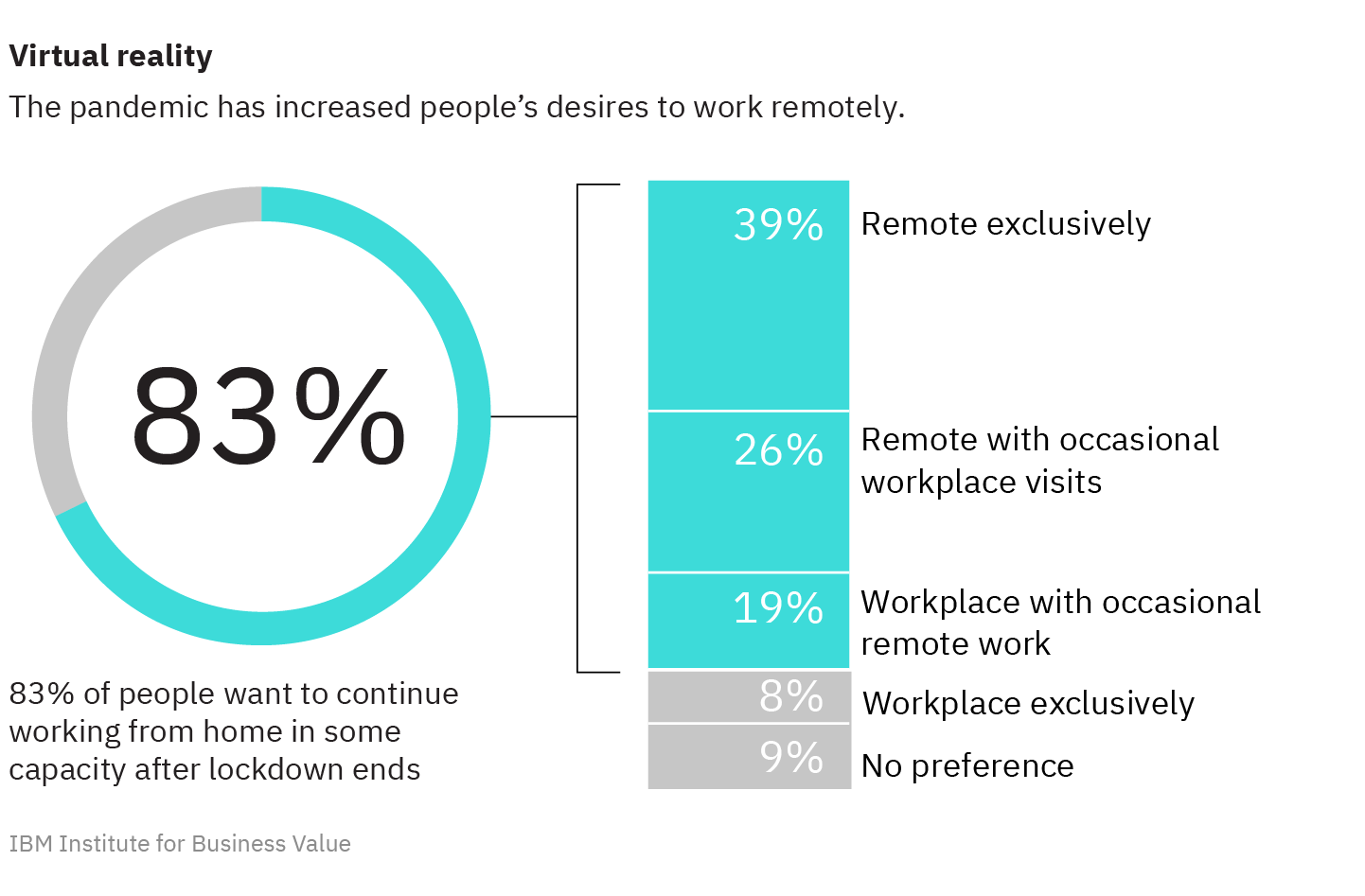
Fewer than one in five employees working from home cite technical and management challenges, but more than one-third cite fears about the health of their family and themselves as the greatest challenge working from home. Of those employees surveyed, one in four cite mental health impacts (such as feelings of loneliness or isolation and lack of motivation) and challenges meeting family and childcare obligations.
Before COVID, about a third of people say they had few interactions with other individuals on a daily basis. And stay-at-home restrictions are almost certain to exacerbate feelings of isolation for those who live alone. Eighteen percent of Americans surveyed indicate they live alone, and more than one in ten experience an even more solitary circumstance: living alone, without the company of even a pet. One-quarter of respondents expressed feelings of loneliness and lack of motivation, brought on by the lockdown.
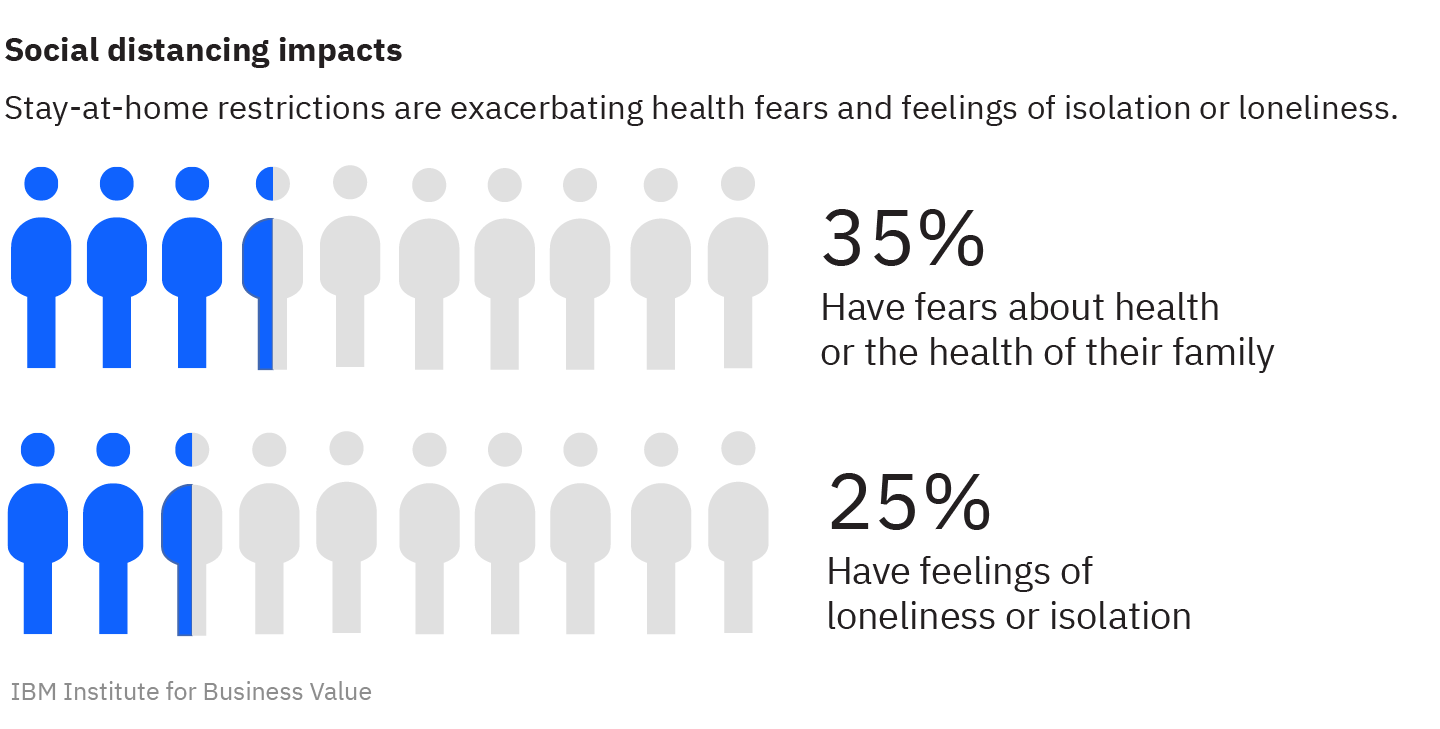
Prior IBV research suggests those living alone—regardless of age or gender—have a higher prevalence of common mental health disorders and that this may largely be explained by loneliness.
To mitigate these concerns to the best of their ability, employees are increasingly finding their own techniques for improving personal interactions, creating alone time/personal space, and sharing family obligations.
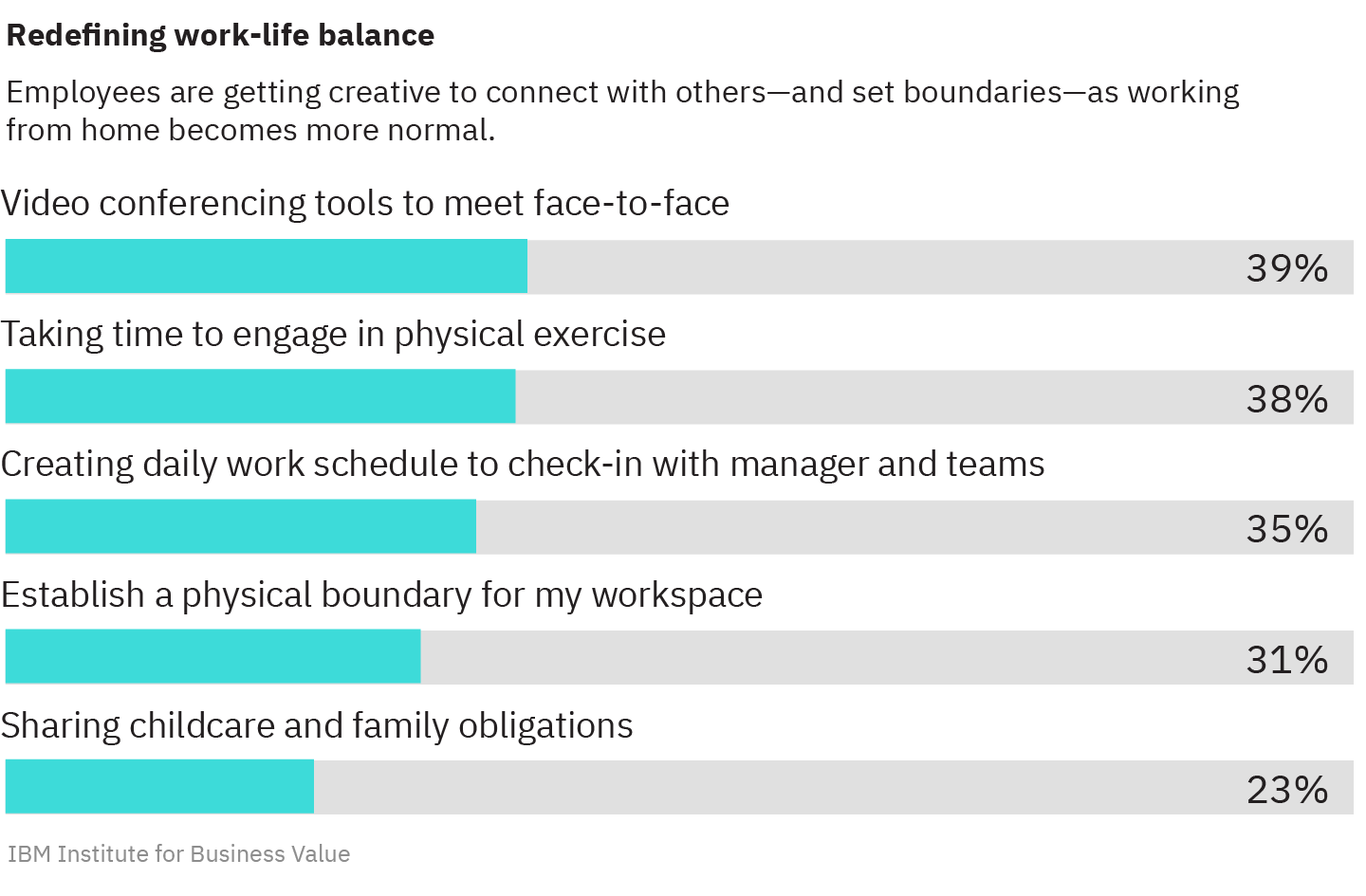
Contact tracing gains support
Given that most people expect COVID-19 to be with us for the foreseeable future—and that they expect another outbreak in the future—it isn’t surprising that most support contact tracing, at least conceptually. Even so, significant trust issues will likely create friction in implementing this capability broadly in the US.
Most people say contact tracing is an important measure to take in order to prevent the spread of COVID-19, and most indicate they would be willing to voluntarily share their data to support it. And 45 percent indicate they expect their employers to have a clearly communicated plan for contact tracing in order for them to return to normal work operations.
However, while nearly 60 percent say they will voluntarily self-report, only 40 percent say they trust others to do the same. And US citizens don’t have faith in their leaders to run contract tracing programs appropriately. The US government is the least trusted entity, with only 31 percent saying the federal government can be trusted to collect and protect personal information and data for contact tracing. Private sector companies fared only slightly better (32 percent).
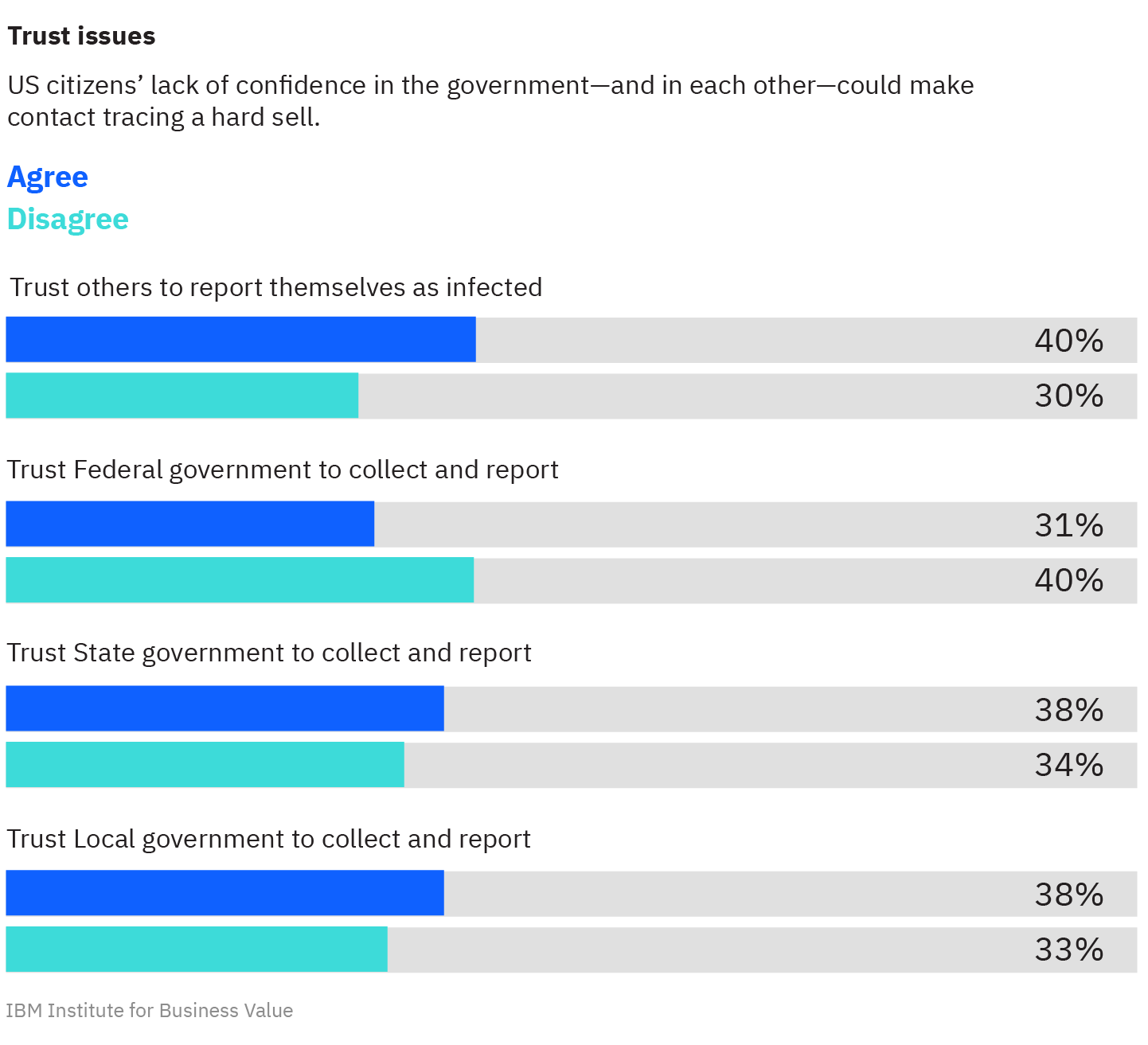
This IBV consumer research is continuing, and we plan to add new questions in the future. Clearly, nothing is “business as usual,” and it may not be for some time. To prepare for what’s next, we will continue to deliver business intelligence that helps leaders navigate disruption. Visit our collection of COVID-19 research frequently to see what’s new.
Meet the authors
Cindy Anderson, Global Executive for Engagement and Eminence, IBM Institute for Business ValueDave Zaharchuk, Research Director, IBM Institute for Business Value
Download report translations
Originally published 23 July 2020



